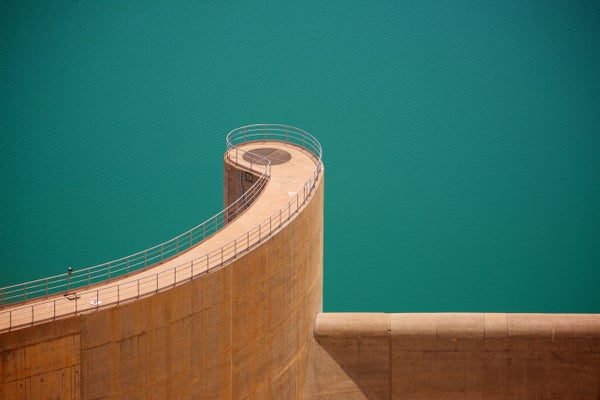When people need more water, they often build dams to increase supply. But can dams increase water use in an unsustainable way, leading communities to live beyond their water means? That appears to often be the case, according to the authors of a recent paper in Nature Sustainability.
Las Vegas is a textbook case. Decades ago the population was projected to reach 400,000 by 2000, so the city built a pipeline to tap into Lake Mead, a reservoir created by Hoover Dam. The population ballooned nearly four times higher than anticipated. Reservoirs can indeed create a “false sense of abundance” in places where “the natural water availability does not fit the population it’s hosting,” says Newsha Ajami, director of urban water policy at Stanford University, who was not involved with the work.
Dams or other water-supply infrastructure such as desalination plants can also make communities less resilient because they mask droughts, says the paper’s lead author, Giuliano Di Baldassarre, a professor of hydrology at Uppsala University in Sweden. Communities may be less likely to reduce their water use until shortages get dire, forcing a sharp reckoning. It’s similar to the way in which a levee protects an area from small floods, encouraging development in the floodplain, making people newly vulnerable to big floods.
On supporting science journalism
If you're enjoying this article, consider supporting our award-winning journalism by subscribing. By purchasing a subscription you are helping to ensure the future of impactful stories about the discoveries and ideas shaping our world today.
Rather than build dams, the authors recommend reducing consumption. That may sound like common sense, but a dam-building boom is underway in developing countries. Conservation can be a significant source of water “supply.” In the U.S. the EPA estimates Americans can use 20 percent less water just by installing water-efficient fixtures and appliances. Nationwide, leaks in U.S. households lose 900 billion gallons of water annually, equal to the consumption of nearly 11 million homes. That doesn’t include leaks in municipal systems.
Another alternative is to capture rain where it falls, rather than rushing it out of a city. Dry areas are increasingly turning to this tactic. The Los Angeles Department of Water and Power captures about 29,000 acre-feet of stormwater annually and is aiming for up to 143,000 acre-feet per year by 2035 That would be enough to supply about 286,000 homes.
Reusing water, whether for toilet flushing, irrigation, industry or drinking is a large potential resource. For example, in 2009 California reused about 0.7 million acre-feet of recycled water—about 13 percent of the wastewater generated. A 2014 analysis by the Pacific Institute, an independent global water think tank in California, estimated the state’s potential was at least an additional 1.2 million to 1.8 million acre-feet per year. California, along with Arizona and Singapore, are leaders in water reuse. But many places have not begun to tap this resource.
Conservation can have huge impacts. Phoenix, Los Angeles, San Diego and Albuquerque would not be the significant cities they are today without water supplied by large reservoirs. Yet water use in the Southwest has remained flat since the 1980s, despite rising populations—just as it has across the U.S., thanks to efficiency measures. This phenomenon may happen when people achieve a certain average income, according to John Fleck, director of The University of New Mexico Water Resources Program who was not affiliated with the study.
Globally, however, annual water demand has continued to rise—from 650 cubic kilometers in 1980 to 1,000 cubic kilometers in 2010. “This is driven by emerging economies,” Di Baldassarre says. Countries including Brazil, China, Ethiopia, India, Mozambique, Rwanda and Turkey are building dams to satisfy demand.
Ajami is frustrated that Western funding agencies and engineering firms are still pushing dams in developing countries when they now understand the social and environmental impacts and have stopped building them at home. In some communities traditional water supply practices still work, and keep people in better touch with the limitations of the resource, she says.
Dams also tend to create hydrological winners and losers, according to Ajami. Between 1971 and 2010, 20 percent of the global population gained water from human interventions on rivers, including dams, but 24 percent were left with less water, according to a 2017 study. Dams on the Euphrates River in Turkey cause water shortages in Iraq and Syria; the ones on the Colorado in the U.S. deny water downstream in Mexico, often leaving the riverbed there dry.
Even with flat demand, use of the Colorado River may already be unsustainable because allocations were based on false assumptions about water availability. Climate change is further tightening the supply, says David Wegner, a consultant and retired adviser on water to the U.S. House of Representatives. There’s a “high potential that significant and severe water restrictions will be put into place,” he says.
Fleck adds, about 70 percent of freshwater used by humans globally goes to irrigated agriculture, where there is a lot of room to reduce demand. A 2015 study found that, globally, nearly half of irrigation water does not benefit crops. Switching to sprinkler or drip irrigation could reduce the nonbeneficial consumption by 54 and 76 percent, respectively, while maintaining crop yields.
The answer to profligate use is better regulation, possibly via higher pricing that would likely suppress demand, says Landon Marston, an assistant professor of civil and environmental engineering at Kansas State University. Even when water becomes scarce, “often it’s free or nearly so,” he notes.
Dams and reservoirs are not innately bad, Di Baldassarre says. But when planning new ones, decision makers should think about these long-term effects and weigh them against other social, environmental and economic costs and benefits. “It’s important to not constrain ourselves for the future,” he says. Now that more than 2.2 million people live in the Las Vegas Valley “there is nothing you can do. We can’t move these people somewhere else.”
